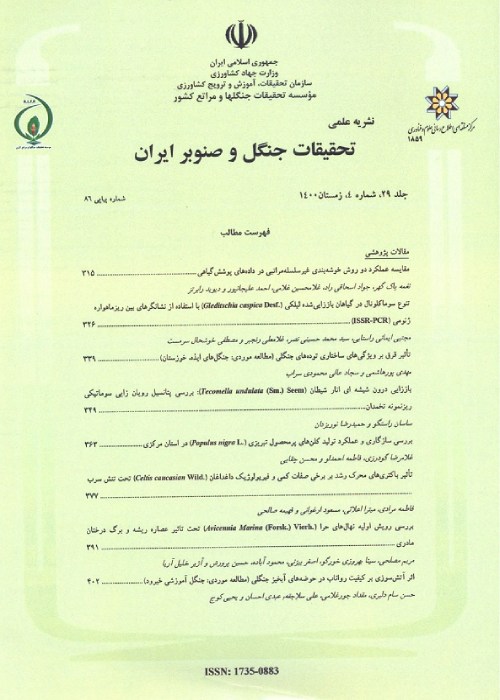A pilot trial on drought resistant tree species irrigated by floodwater
Author(s):
Abstract:
Tree planting with drought tolerant species, particularly Acacia and Eucalyptus species may be considered as a logical method for rehabilitation of marginal lands which can potentially meet the needs of local people in terms of wood, fuel wood, fodder, edible fruits, etc. These goals may be much better attained when the trees are planted in floodwater spreading (FWS) systems which drastically change the desert ecosystems through provision of more water and better rooting environments. In 1994, a pilot project was carried out in FWS systems in Gareh Baygan Plain in Fars Province of Iran to study the growth and performance of four Eucalyptus and four Acacia species which had previously been tested successfully in a preliminary adaptation experiment. A randomized complete block design with four replications was employed to establish the experiment. Each replication comprised of eight plots (species) and each plot contained 49 trees with 3m×3m spacing. The seedlings were irrigated only by rain and ephemeral floodwaters. In a ten year period, growth parameters including survival percentage, height and diameter at breast height were assessed or measured every year. The existence of pests or diseases and the viability of the trees were also monitored annually and the final evaluation was made at the age of ten. Survival and growth performance of the trees were quite satisfactory. Eucalyptus camaldulensis, E. oleosa, Acacia victoriae, A. salicina, and E. microtheca were all promising species, showing over eighty percent survival in the final year of experiment and were not significantly different from each other. The survival of E. fruticetorum was significantly different (p=0.0001) from those of the other species. Eucalyptus camaldulensis showed the highest growth in terms of height and diameter, while A. saligna ranked the lowest. It may be concluded that E. camaldulensis, E. oleosa, E. microtheca, E. fruticetorum, A. salicina, and A. victoriae were highly promising species and may be recommended for large-scale plantations in arid zones of southern Iran, using floodwater spreading systems. Moreover, further tests of cold resistant provenances of A. cyanophylla and A. saligna are recommended.
Language:
Persian
Published:
Iranian Journal of Forest and Poplar Research, Volume:18 Issue: 1, 2010
Page:
90
magiran.com/p757019
دانلود و مطالعه متن این مقاله با یکی از روشهای زیر امکان پذیر است:
اشتراک شخصی
با عضویت و پرداخت آنلاین حق اشتراک یکساله به مبلغ 1,390,000ريال میتوانید 70 عنوان مطلب دانلود کنید!
اشتراک سازمانی
به کتابخانه دانشگاه یا محل کار خود پیشنهاد کنید تا اشتراک سازمانی این پایگاه را برای دسترسی نامحدود همه کاربران به متن مطالب تهیه نمایند!
توجه!
- حق عضویت دریافتی صرف حمایت از نشریات عضو و نگهداری، تکمیل و توسعه مگیران میشود.
- پرداخت حق اشتراک و دانلود مقالات اجازه بازنشر آن در سایر رسانههای چاپی و دیجیتال را به کاربر نمیدهد.
In order to view content subscription is required
Personal subscription
Subscribe magiran.com for 70 € euros via PayPal and download 70 articles during a year.
Organization subscription
Please contact us to subscribe your university or library for unlimited access!


